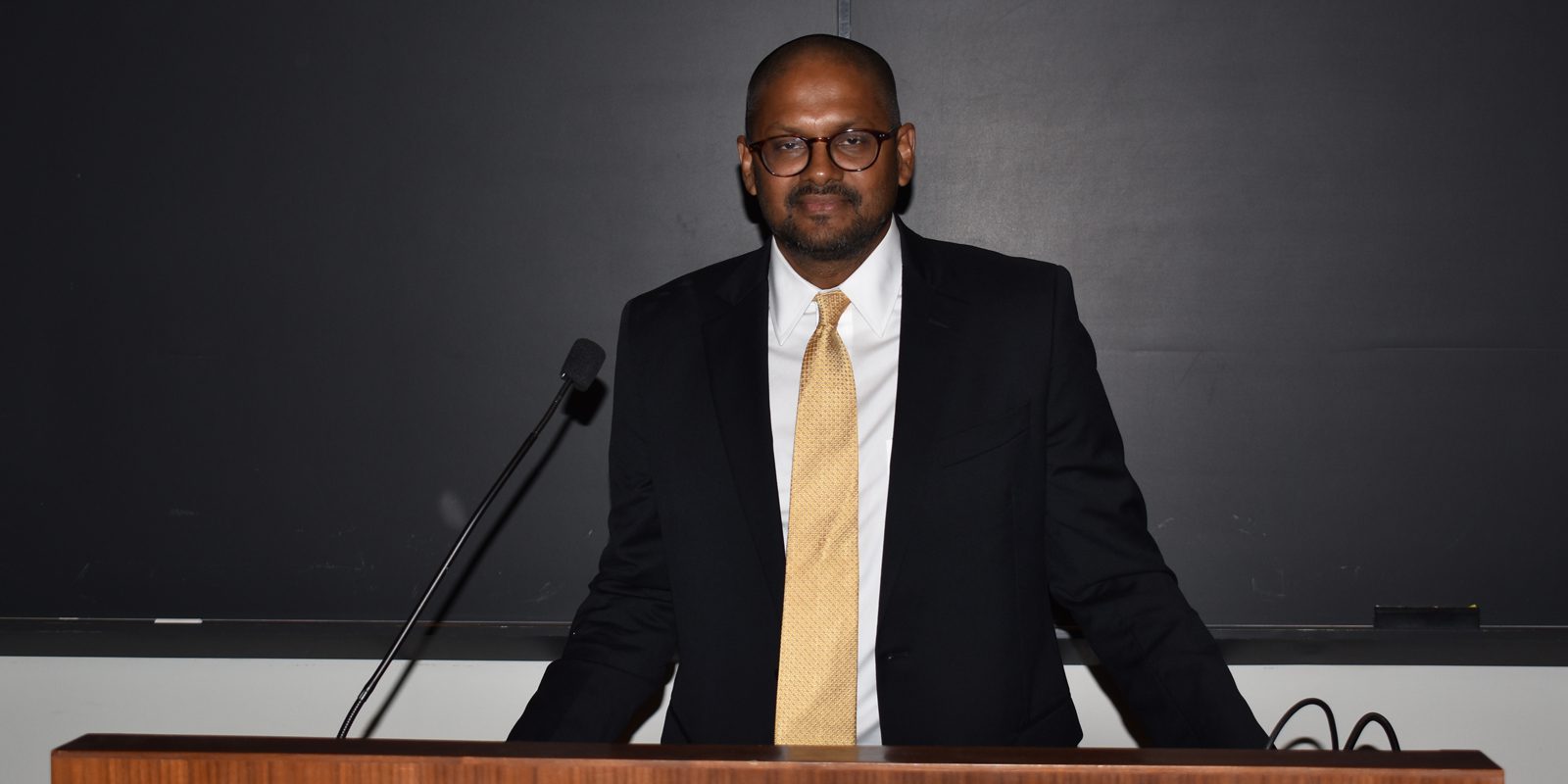Journalist Ida B. Wells exposed lynching as a terrorist political weapon, Assistant Professor of Politics Desmond Jagmohan argued at the 2018 Constitution Day Lecture. He depicted lynching as a disciplinary act that reconstitutes a community along racial lines in defining who counts as a rights-bearer.
He explained that before Wells, a popular view still common today portrayed lynching as spontaneous. Yet Wells showed that the attacks exhibited deliberation. They often drew aid from newspapers, the main sources of education along with entertainment in the nineteenth century.
First, newspapers exploited widespread fears to incite violence against those accused of crimes. Secondly, they coordinated mobs, sometimes wittingly. Publishing details about, say, the addresses of suspects, made them easy targets. One newspaper announced a lynching before it happened and so essentially called for it: “John Hartfield will be lynched by Ellisville mob at 5 o’clock this afternoon.” Finally, newspapers symbolically reproduced lynching so as to extend its reach.
“Newspapers played a nontrivial role in subverting justice. They even encouraged readers to determine the outcome of the story by playing the critical part,” Jagmohan said. He noted that for Wells, yellow journalism poisoned democracy, replacing a judicial system built on courts with mob rule.
Born in 1862 in Mississippi, Wells attended a missionary school and, as a product of the temperance movement, abhorred alcohol. At 16, she lost her parents to yellow fever. Newly responsible for raising her seven younger siblings, she found employment as a teacher by day, while writing articles and organizing social or literary clubs for women by night, Jagmohan said.
“The culture of school, love, and church life was her training ground,” he noted.
As Wells denounced wrongs like segregation and disenfranchisement, black and white Southerners alike condemned her outspokenness as unladylike. Yet in speaking the truth, however ugly, she discovered her vocation as a journalist.
Like Thomas Jefferson and Alexis de Tocqueville, she believed free press essential to free institutions. No educator compared with the newspapers, she insisted.
Over the next decade, Wells wrote exclusively on lynchings. She showed that they arose not as responses to suspected rape or murder, but rather as rituals fueled by racial resentment from economic depression. The financial struggles of the New South instilled a sociosexual anxiety and self-perception of impotence among white men, she claimed.
“White men experienced the transformation as a loss of sovereignty over their homes and the bodies of their wives,” Jagmohan explained.
Aggrieved, they constructed black men as moral and sexual predators. Black bodies came to represent a public threat for the first time.
Wells argued that, to combat the new narrative, journalists ought to mobilize the truth in service of justice. She advocated not only relating facts, but also providing moral arguments, stirring intuitions to motivate action.
Jagmohan said her approach exemplified Michel Foucault’s concept of parrhesia. Meaning “frankness in speaking the truth,” parrhesia involves a less powerful speaker who, in criticizing a majority or tyrant, deserves praise for upholding moral principles despite personal, social, and professional dangers.
“Wells chose to live as a truthteller in exile, rather than as someone false to herself. She was willing to risk life and liberty for criticism,” he said.
However, Jagmohan challenged Wells’s belief in an obligation to engage in fearless speech. He gestured toward the underexplored political theory literature about purposeful deceit as a means to noble ends.
Locating the most comprehensive defense of political deception in the American slave narrative, he quoted Harriet Jacobs: “‘Who can blame slaves for being cunning? They are constantly compelled to resort to it. It is the only weapon of the weak and oppressed against the strength of their tyrants.’”
Bondsmen and women needed the façade of compliance while secretly cultivating the skills to combat slavery, he explained.
“The absence of fearless speech is not agreement or compromise,” he said. “You may have the right to risk your own life and limbs, but you do not have the right to risk the life and limbs of others. If fearless speech places the members of your institution in harm’s way, then I fail to see how it can serve as a mark of leadership.”
Jagmohan emphasized that he aimed not to critique Wells, but rather expand her conception of what counts as resistance to oppression.
Similarly, respondent Hendrik Hartog, Class of 1921 Bicentennial Professor in the History of American Law and Liberty as well as Professor of History, suggested that fearless speech and constrained speech may overlap as categories.
Noting that lynching qualified as legal, Hartog construed the struggle between Wells and the yellow press as a war between constitutional visions. One identified lynching as a constitutional extension of a legitimate criminal law, which articulated the values of a white male majority. The other, voiced by Wells, treated print as a way to change the scope of the constitutional.
“For her, the aspiration is to label the apparent legality of lynching as a mark of the unconstitutionality and moral failure of the Jim Crow regime,” Hartog said.
Introducing the lecture, Anne Cheng ’85, Director of American Studies and Professor of English, said the Office of the Provost entrusted the Program in American Studies with hosting annual programming for the federal observance of Constitution Day. Observed every September 17, Constitution Day commemorates the 1787 ratification of the United States Constitution and recognizes all citizens, whether from birth or naturalization.
Titled “Constituting Justice: Ida B. Wells’s Anti-Lynching Campaign,” the lecture took place on Wednesday, September 12 at 4:30 p.m. in Arthur Lewis Auditorium, Robertson Hall. It was co-sponsored by the James Madison Program in American Ideals and Institutions along with the Program in Law and Public Affairs.
By Ruby Shao ’17
















